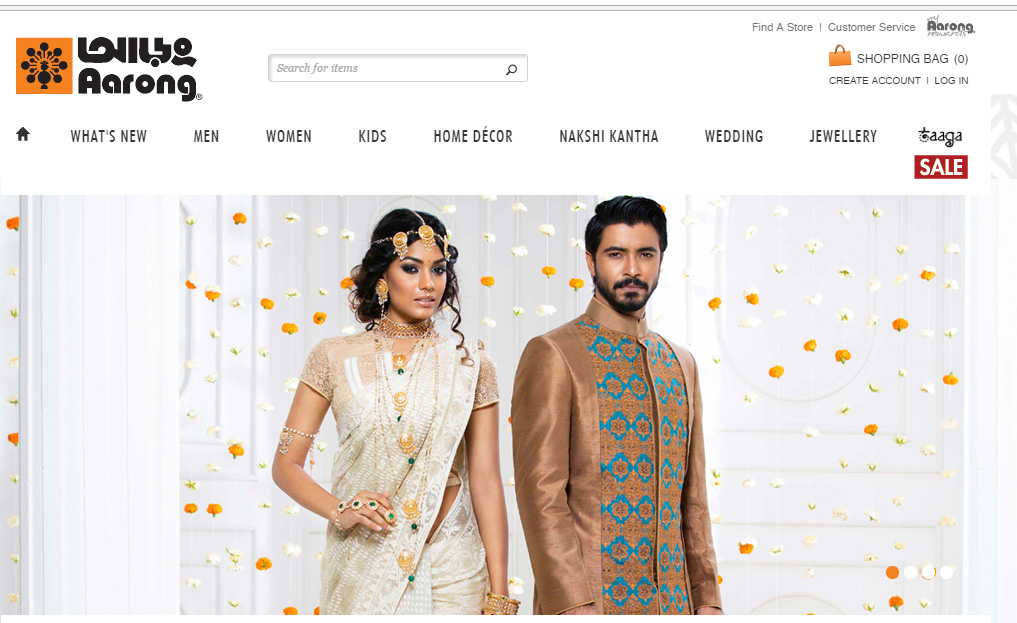
Aarong is BRAC’s flagship social enterprise, and Bangladesh’s most popular lifestyle retail brand. The word Aarong means ‘village fair’ in Bangla. It consists of 22 outlets (21 physical and one online store) and sells handcrafted products made by more than 65,000 artisans located all over the country. Aarong is a team of over 3800 people.
In 1976, BRAC organized groups of women in Manikganj and Jamalpur, trained them in sericulture and making handmade products such as block printed and embroidered cushion covers, bed covers, etc. and started to supply these products to shops in Dhaka. BRAC quickly realized that these shops paid for these products not when they were delivered, but in fact, once they were sold. It took months for these women to get paid for the goods. This was when BRAC decided to open its own retail outlet, and the first Aarong shop opened on Mirpur Road in Dhanmondi in 1978.
"From the very first day, Aarong maintained the policy of paying its artisans and producers when products were delivered and Aarong took on the risk and responsibility of financing and selling the inventory," BRAC’s Senior Director Tamara Hasan Abed told FS in an interview in January.
Over the past few decades, Aarong has grown manifold and become a household name among urban consumers in Bangladesh. While it started with a few product lines initially, it now offers a vast range of products and is adding more categories regularly. Aarong has not only played a pioneering role in developing, promoting and protecting the rich heritage of Bangladeshi crafts such as Nakshi Kantha and Jamdani, but has also left an indelible mark on the fashion industry in Bangladesh.
In 1976, Ayesha Abed, the late wife of Sir Fazle Hasan Abed, founder of BRAC (NGO)BRAC, initiated many of the major activities of Aarong by identifying and experimenting with various crafts that women could produce at homes such as Nakshi Kantha, embroidered goods, baskets, mats and items made of cane, bamboo, and jute.
In 1978, BRAC opened its own retail outlet in Dhaka called Aarong – meaning 'village fair.'
During the late 1970s and early 1980s, BRAC focused on developing Aarong's product lines and production capabilities. It began to study and catalog the designs and motifs of traditional art forms. It started experimenting with indigenous forms and materials, adapting them to possible new lines. It hired master craftsperson to help train village women and created a textile design and service workshop in Manikganj to experiment with materials and technologies in stitching, weaving, and dying. BRAC also started producing historically imported items such as men's Panjabi.
In 1982, the Ayesha Abed Foundation (AAF) was established to develop women's skills in various crafts through an appropriate working environment, financial and technical assistance and training.
AAF's first project, the Manikganj center, was opened on 3 September 1983. The foundation buys handicrafts made by the village women, other NGOs and handicraft producers. In addition to starting the AAF, Aarong opened four retail outlets and began exporting a small percentage of goods to fair-trade organizations. Today, AAF has 13 main centers linked to more than 600 subcentres.
Aarong began to emerge as a fashion brand. It was among the first brands to start organizing photo shoots, fashion shows, exhibitions and other forms of media-focused events. It participated in its first international fashion show in 1999. Through these initiatives, Aarong was able to expand its popularity and brand identity within Bangladesh.
During the late 1990s and early 2000s, Aarong went through a challenging phase due to management problems and a lack of innovation. Between 2001 and 2004, the company was restructured to improve everything from costing, pricing, design, and marketing to new product introductions and brand innovations.
From a single shop, Aarong has grown into one of Bangladesh's biggest retail chains, with 21 stores spread across the major metropolitan areas of the country – in Dhaka, Chittagong, Comilla, Khulna, Sylhet, Narayanganj, Bogra and Mymensingh. The company also operates 13 AAF centers while ensuring the livelihood of over 65,000 artisans.
In 2018, it has launched a host of new product lines, categories, and brands, including Taaga and Herstory. In July 2018, Taaga opened a separate outlet in Saat Masjid Road in Dhanmondi to display products exclusive to the brand aimed at young men.
It has launched Aarong eCommerce platform. It currently delivers products anywhere in Bangladesh. It also plans to launch a global e-commerce platform to cater to customers living abroad. Aarong has a strong following among NRBs, and it wants to serve them through its eCommerce platform.
Aarong launched its loyalty program ‘My Aarong Rewards’- a brand loyalty programme and a membership scheme to acknowledge regular and loyal customers of Aarong.
Aarong sells over 100 different types of lifestyle products. It has been growing at a 15% rate every year. In 2017, it generated over BDT 850 crores in revenue.
Aarong celebrates 40 years of its phenomenally successful existence. It is the largest and most successful craft organization globally.
